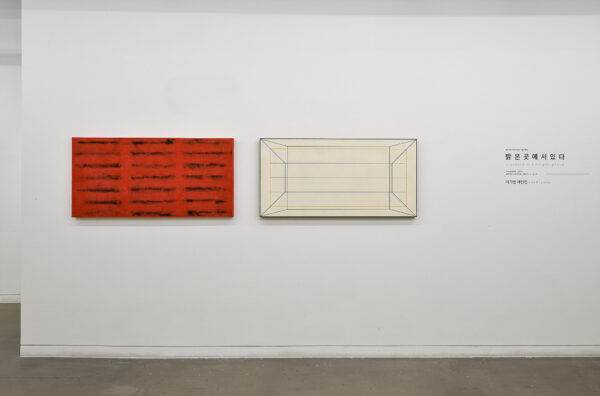깊은 구지
| [GALLERIES] Gallery Bakyoung
2022. 3. 3 – 5. 27
이주형

외적으로 보아 풍경의 형태를 보여주고 있는 일련의 곡 시리즈는 대개 능선과 공지선을 경계 삼아 화면 아랫부분의 땅과 화면 윗부분의 하늘로 나누어져 있다. 여기에 작가의 트레이드마크에 해당하는 형태가 때로 땅 위에 그리고 더러 하늘 위에 아니면 경계 위에서 서성이고 있다. 땅은 대개 파헤쳐진 벌건 속살을 드러내고 있는데, 실제 지형에 충실한 것이라기보다는 작가의 몸을 표현한 것일 터이다. 그곳에 대한 몸의 흔적을, 몸의 기억을 그린 것일 터이다.

어떻게 그런가. 여기서 메를로 퐁티의 우주적 살 개념이 도움을 줄 수 있겠다. 주체와 객체는 우주적 살로 덮여 있어서 서로 분리할 수가 없다. 주체의 의식과 무관하게 주체는 이미 객체의 일부이다. 그러므로 객체가 없으면 주체도 없다. 그렇게 객체는 주체를 이미 자신의 일부로서 예정하고 있었다. 비록 거기에 지금 나는 없지만, 내 몸(몸의 흔적, 몸의 기억)이 풍경의 살이 되어 거기에 여전히 그대로 간직되고 있었다. 그러므로 지금 그곳을 방문하는 행위는 그 풍경의 일부인 나와 재회하는 것이 된다. 아니면 그저, 아니, 이마저도 이러한 사실(어쩌면 자의식)과 무관하지 않은 것이지만, 파헤쳐진 채 벌건 속살을 드러내고 있는 풍경 자체를 사실은 작가의 황량한 마음을 풍경에 투사해 본 것으로 보아도 좋을 것이다.

땅 위에는 얼핏 점 같기도 하고 작은 막대 같기도 한 비정형의 형태가 패턴을 이루고 있는데, 차양막을 설치하기 위해 그리고 줄을 치기 위해 밭에다 심어 놓은 막대를 연상시킨다. 그렇게 실제 풍경의 일부를 떠올리게 하지만, 동시에 혹은 이보다는 그곳에 얽혀 있는 작가의 흔적을, 일종의 심상 흔적을 표상할 수도 있겠다.
그리고 작가의 그림에서 흥미로운 것이, 유독 늪(늪의 언어)이 많고, 습지가 많고, 사구(사구가 보이는 풍경, 모든 것은 사막에서 마친다)가 많다. 그리고 여기에 곡까지. 작가는 자신의 삶에서 바짝 마른 명확함을 보여주고 싶지만, 정작 그런 명확함과는 거리가 먼 곳들이다. 늪도 그렇지만 습지도 하나같이 물인지 뭍인지 경계가 불명확한 곳이다. 그런가 하면 사구란 불어오는 바람에 따라 움직이는, 가변적인, 변화무상한 모래언덕이다. 그래서 정해진 형태가 따로 없다.

여기에 곡은 어떤가. 질 들뢰즈의 <천 개의 고원>은 천 개의 곡으로 이루어져 있다. 의식을 표상한 것인데, 의식은 표면과 이면이 천 개의 주름으로 접힌 주름 구조로 이루어져 있다. 표면의 의식과 주름 속에 숨어서 의식의 레이더에는 포착되지도 않는 무의식으로 이루어져 있다. 의식을 간섭하는 의식의 그림자, 의식의 함정, 의식의 지향호(메를로 퐁티)라고 해야 할까(비록 이로 인해 비로소 의식이 가능하고 또한 수정되기도 하지만, 여하튼).
바로 작가가 실제의 피부로 체감하는 삶의 질감이 그렇다고 해야 할까. 그렇게 작가는 이상과 실제, 표면과 이면의 거리감을 느낀다. 때로 표면과 이면이 뒤집힌 채 혼성되는 삶, 경계 위의 삶, 이중적이고 다중적인 삶의 그림자를, 양가적이고 가변적인 삶의 함정을 실감하는 것이다. 아마도 작가의 분신이 여전히 알 듯 모를 듯한, 그저 머리칼 같고 털 뭉치 같다는 막연한 이름으로 부를 수밖에는 없는, 그런, 유보적인 상황 논리와도 통하는 부분이 있을 것이다. 작가의 그림은 바로 그런, 유보적인 상황 논리를, 다만 상황 논리가 유보적이어서 그렇지 분명한 실체를 가지고 있는 존재론적인 조건을 다루고 있다는 점에 작가만의 아이덴티티가 있고 미덕이 있다.
고충환(미술평론)

갤러리박영
경기도 파주시 회동길 37-9
031-955-4071











